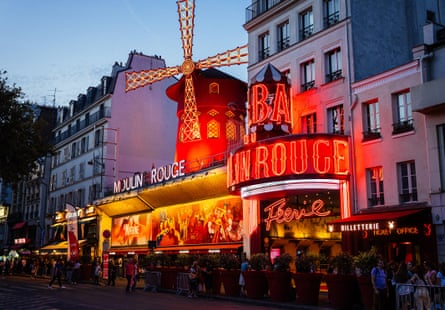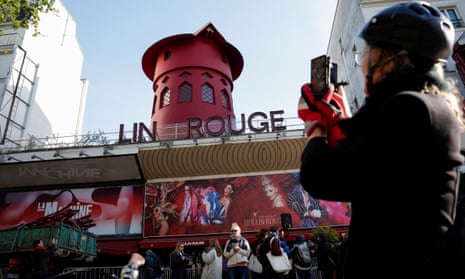The home of the high-spirited French can-can has been laid temporarily low after the sails of the red-painted windmill on top of the Moulin Rouge, the most celebrated cabaret in Paris, tumbled inexplicably to the ground in the early hours.
“In 135 years of history the Moulin Rouge has experienced many adventures, but it is true that as far as the sails are concerned, this is the first time it’s happened,” the attraction’s general manager, Jean-Victor Clerico, told reporters.
Clerico said that shortly before 2am on Thursday, the sails of the windmill “simply gave way, and fell on the pavement. Fortunately at the time the boulevard was empty of passersby. We are especially relieved this morning to know there were no injuries.”

More than 600,000 people a year watch the twice-daily shows at the Moulin Rouge at the foot of the Montmartre hill, with more standing on the pavement outside to take selfies in front of a landmark as emblematic of Paris as the Louvre or the Eiffel Tower.
Founded in 1889, the cabaret became a global symbol of fin-de-siècle Parisian nightlife, its famed can-can dancers depicted in paintings by artists such as Toulouse-Lautrec. An eponymous 2001 film by Baz Luhrmann cemented its present-day appeal.
The French can-can is believed to have evolved from the final figure of a dance for couples known as the quadrille. It caused considerable scandal when it first became popular as a cabaret act mainly because of its intentionally revealing high kicks.
Performed by a line of female dancers, the dance as devised in the early 1920s by Pierre Sandrini, then the artistic director of the Moulin Rouge, revolves around the “vigorous manipulation of skirts and petticoats, high kicks, jump splits and cartwheels”.
Moulin Rouge: les ailes tombées cette nuit sont en train d'être évacuées pic.twitter.com/LUeU5hOgK0
— BFMTV (@BFMTV) April 25, 2024
While it was recently closed for 18 months for renovation during the pandemic, the cabaret’s only serious previous accident was a fire that erupted during building works in 1915 that forced it to shut its doors for nine years.
Officials, Parisians and tourists alike were shocked by the incident. “The Moulin Rouge is part of our cultural heritage, a building famous throughout the world and above all in the hearts of the people of Paris,” said the capital’s mayor, Anne Hidalgo, adding that the sight of the fallen sails was “a saddening one”.
Raphaël, a local resident, told Le Parisien it was “quite upsetting to see the windmill without its sails – it’s a symbol of Pigalle and of all Paris”. André Duval, the front-of-house manager in the 1980s and a neighbour for 50 years, was equally shocked.
“Paris without its windmill is like Paris without the Eiffel Tower,” he said.

Clerico said there was no evidence of foul play and the cause was “obviously a technical problem”. The Paris police chief, Laurent Nuñez, confirmed that no one had been hurt, “safety architects” had been dispatched to the scene, and there was no risk of further collapse.
A source at the cabaret, among the most visited landmarks in one of the world’s most visited cities, told French media the windmill’s mechanism was checked weekly and that no problems had been recorded during the last inspection.
